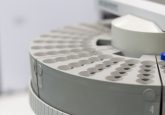New test uses Raman spectroscopy to detect cancer biomarker in urine

Researchers at the University of Victoria (Victoria, Canada) have developed a new test that uses surface enhanced Raman spectroscopy (SERS) to detect biomarkers for lung cancer in urine.
The early detection of lung cancer is very challenging and current clinical methods are not overly effective at the early stages, leading to poor patient prognosis.
This novel diagnostic test detects the exogenous cancer biomarker, acetyl amantadine (AcAm), which is known to be a product of a metabolic process that is widely recognized to be significantly upregulated in cancerous cells.
Previously, quantification of AcAm in urine relied upon LC–MS, which is expensive and comprises long run times, making it undesirable for clinical application. The team’s new diagnostic test is capable of overcoming these limitations, however, with the application of SERS in the detection of AcAm.
According to the group, the new test achieved a detection limit of 1 ng mL−1 of AcAm in mock urine in the absence of steroids and without the need for extraction or other pre-treatment methods. The team further discovered that with levels of corticosterone typical of urine, the limit of detection was 30-times higher.
Since the approach functions with samples containing high concentrations of salts and organic co-solutes, typical of urine, it is anticipated that the new diagnostic platform has the potential to reduce cost and speed up processing, as pre-purification of the sample is not required.
In terms of future work, the group intends to compare their approach to existing methods and to apply the test to real urine samples.
Source: Cao G, Hajisalem G, Li W, Hof F, Gordon R. Quantification of an exogenous cancer biomarker in urinalysis by raman spectroscopy. Analyst DOI: 10.1039/C4AN01309C (2014) (Epub ahead of print).






